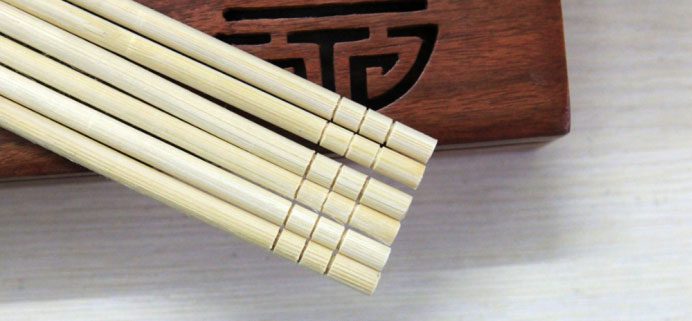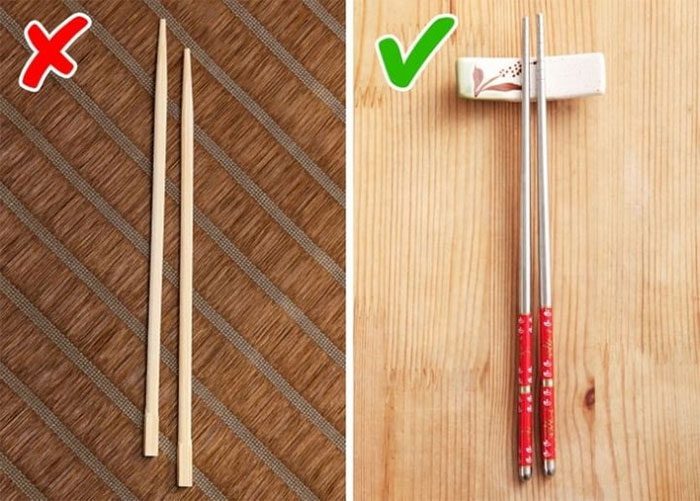Many opinions suggest that the circles appearing on the ends of disposable chopsticks indicate how many times the chopsticks have been recycled, but is that really the case?
Despite being a very familiar item, not everyone understands the significance of the circles that appear on the ends of disposable chopsticks.
The Meaning of the Engraved Circles on Chopstick Ends
If you closely observe used chopsticks, you will notice that the ends are engraved with either 2 or 3 circles, and some may have no circles at all. According to manufacturers, these circles are symbols indicating the number of times the chopsticks have been recycled.
A chopstick end without circles means it is newly produced and has never undergone recycling. Conversely, chopsticks with 2 circles have been used once and recycled for a subsequent use. Similarly, chopsticks with 3 circles have undergone 2 recycling processes. After the third recycling, these chopsticks are to be disposed of to ensure user health.

Engraved circles on chopstick ends.
There are also opinions suggesting that the number of circles on chopstick ends to signify recycling frequency is not substantiated. The engraving of circles on chopsticks may simply serve to mark which end is the top or bottom. Additionally, the engraved circles also serve an aesthetic purpose, making the chopsticks look more attractive.
How Often Should You Replace Chopsticks?
You should replace chopsticks every 3 to 6 months, regularly paying attention to cleanliness and keeping them dry. They should be sterilized frequently with hot water, and any chopsticks that show signs of mold should be discarded immediately.
If you notice the following signs on your chopsticks, you should also dispose of them right away:
- Rough, discolored chopsticks: Many people do not dry chopsticks after washing them and place them directly in the cabinet. Leaving chopsticks in a damp environment for an extended period can easily breed bacteria, causing the surface to darken and mold. Once mold develops, the level of aflatoxin can be quite high, which can be harmful to health.
- Chopsticks with cracks or grooves: No matter the type, any signs of scratches or cracks on chopsticks can lead to harmful bacteria growth, so they should not be used any longer.
- Chopsticks with an odor: If chopsticks are clean but still have a distinctly sour smell, it means they are contaminated or have exceeded their usable lifespan. At this point, bacteria on the chopsticks may have multiplied significantly. Continuing to use them means bacteria can enter the mouth along with food, posing a serious health risk.
- Discolored plastic chopsticks: Most plastic chopsticks are made from melamine and formaldehyde, which can easily break down harmful chemicals at high temperatures, posing significant risks to human health. Therefore, when plastic chopsticks become discolored or deformed, they should be discarded immediately.
- Disposable chopsticks: During production, disposable chopsticks are sterilized using sulfur, and when heated, sulfur dioxide can contaminate food. Regular use can easily erode the mucous membranes of the respiratory tract, leading to cancer. Moreover, disposable chopsticks must be bleached with hydrogen peroxide during production. Hydrogen peroxide is highly corrosive and can easily damage the mouth, esophagus, and even the stomach.

Replace chopsticks every 3 to 6 months.
What Type of Chopsticks Should You Choose?
You should prioritize using natural wood types or wood commonly used to make chopsticks, such as rosewood, ebony, bamboo, coconut wood, or stainless steel chopsticks for durability and safety over frequently using disposable bamboo chopsticks.
Bamboo and Wooden Chopsticks
- Advantages: Lightweight, moderately priced, and easy to use.
- Disadvantages: Prone to cracking, can harbor dirt and bacteria, so they should be replaced frequently.
Stainless Steel Chopsticks
- Advantages: Attractive, lightweight, easy to use, corrosion-resistant, and rust-free.
- Disadvantages: They have high thermal conductivity and can cause burns when handling hot food, which is not suitable for the elderly and children.
Ceramic Chopsticks
- Advantages: Stable properties, safe materials, exquisite patterns, and a formal appearance.
- Disadvantages: Can feel heavy, tend to be more expensive, and are prone to breaking.
Plastic Chopsticks
- Advantages: Bright colors, unique shapes, and are popular with children.
- Disadvantages: They can easily deform when heated and may release harmful substances into the human body.
Why do Koreans use the “hardest chopsticks to use in the world”?





















































